NORTH WALES COAST RAILWAY:NOTICE BOARD
Rheilffordd arfordir gogledd Cymru: Hysbysfwrdd
15 October 2018
Share on Twitter
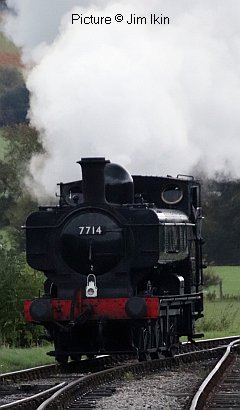
Tweets by @NWrail1
Contributions and comments are encouraged: see the Contributions Page
October 2018
November 2018
Friday 2 November Clwyd Railway Circle “The Development of Railways in the UK” A look at rail development from Trevithick through to the 23,000 miles of railway in the UK by 1921. Mike Blackburn
Tuesday 6 November North Wales Railway Circle Illustrious local photographer Barry Wynne assisted by Steve Morris.
Friday 9 November Altrincham Electric Railway Society. Steam through Skelton Junction and Timperley Junction 1955-1968. A digital presentation by Tony Martin.
Monday 19 November RCTS Chester "Through Kirton Tunnel" Stephen Gay
December 2018
Tuesday 4 December North Wales Railway Circle Christmas Social & Members' Evening.
Wednesday 5 December RCTS Liverpool "BR in the North West" Tom Heavyside
Friday 7 December Clwyd Railway Circle “Members Night & Christmas Celebrations”Members are invited to give a 15 minute presentation of their choice (any format). FREE tea/coffee & festive treats during the interval. Contact David Jones 01244 537440 to book a slot.
Friday 14 December Altrincham Electric Railway Society. People & Places 3. images of railway staff, enthusiasts, the general public and the steam railway. A digital presentation by Paul Shackcloth.
Monday 17 December RCTS Chester "The Fate of The Irish Mail" Tony Griffiths (A film which relates the story of the Abergele disaster in 1868)
January 2019
Friday 4 January Clwyd Railway Circle “West Country Memories” An illustrated talk which includes all the branch lines of Devon and Cornwall. Dave Southern
Tuesday 8 January North Wales Railway Circle (Speaker to be announced) The Bala Lake Railway
Friday 11 January Altrincham Electric Railway Society. Journeys through Wales during the 1960s including narrow gauge railways A colour slide presentation by Bill Chapman.
Monday 21 January RCTS Chester AGM, followed by "A Photographic Tribute to Edgar Richards"( Non-members are invited to attend from 20.00 hours)
February 2019
Friday 1 February Clwyd Railway Circle “The Glorious Steam Railways of India” The images were taken when it was a fully steam worked system, with a variety of steam across four different gauges. John Sloane
Tuesday 5 February North Wales Railway Circle [To be announced]
Friday 8 February Altrincham Electric Railway Society Steam and Diesel in the Northern Fells 2010-2016. A digital presentation by Ian Pilkington.
Wednesday 6 February RCTS Liverpool "North West & North Wales Reminiscences of the 1960s" John Cashen
Monday 18 February RCTS Chester "A Taste of Japan" Gordon Davies
March 2019
Tuesday 5 March North Wales Railway Circle Humph Davies with mostly narrow-gauge archive material.
Friday 1 March Clwyd Railway Circle “Annual General Meeting” followed by “Chairman’s Choice” A night of self indulgence from the retiring chairman, David Jones
Friday 8 March Altrincham Electric Railway Society. The Glorious Steam Railways of India. Steam across India from 1976 to the early 1980s. A digital presentation by John Sloane.
Monday 18 March RCTS Chester "55 Years of Railway Photography, Part 2" Les Nixon
April 2019
Tuesday 2 April North Wales Railway Circle Gareth Haulfryn Williams, archivist and author, on 'Rails to/from Bethesda.'
Wednesday 3 April RCTS Liverpool "Manchester to Liverpool by CLC" Ken Grainger
Friday 5 April Clwyd Railway Circle "Scotland in the 1960s" The talk covers the whole of Scotland - going up the west side to Wick and Thurso and returning down the east side from/to Carlisle.
John Cashen
Friday 12 April Altrincham Electric Railway Society Great Western and Southern Steam in the West Country. A colour slide presentation by Alf Storey.
Monday 15 April RCTS Chester "Steam on the North Wales Coast" (Video Presentation) Ron Watson Jones
May 2019
Tuesday 7 May North Wales Railway Circle AGM and Members' Photo. Competition.
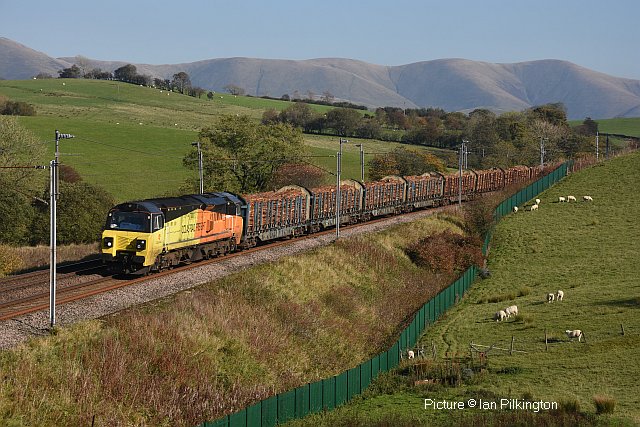
70 817 heads 6J37 Carlisle - Chirk logs near Grayrigg on Wednesday 10 October. The train used the West Coast line due to a failed freight causing delays on the Settle - Carlisle route. Picture by Ian Pilkington.
Quite a lot going on this week - Ffestiniog reports will have to be held till next week. Thanks as always to all contributors and rail staff. - Charlie
End of an era - pictures by Rhodri Williams
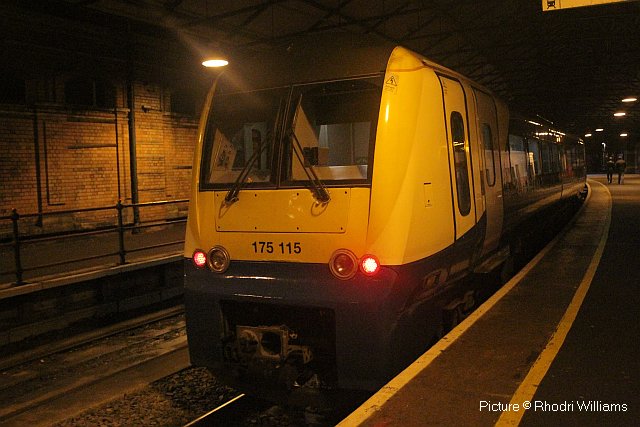
Saturday 13 October was the last day of Arriva Trains Wales before the new operator KeolisAmey took over, under the brand name Transport for Wales (TfW). Rhodri travelled to Holyhead on 13 October to photograph 175 115 waiting to work the last Arriva departure from the port, the 20:37 to Crewe. (The very last arrival, at 23:15, was the 21:00 from Crewe.)
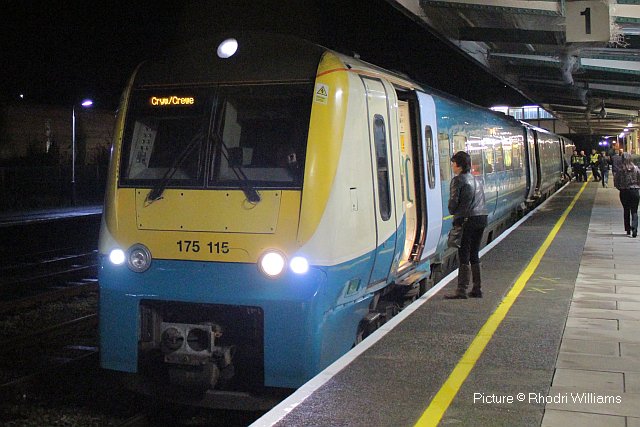
Rhodri travelled on 175 115 to Bangor, where it became the last Arriva departure.
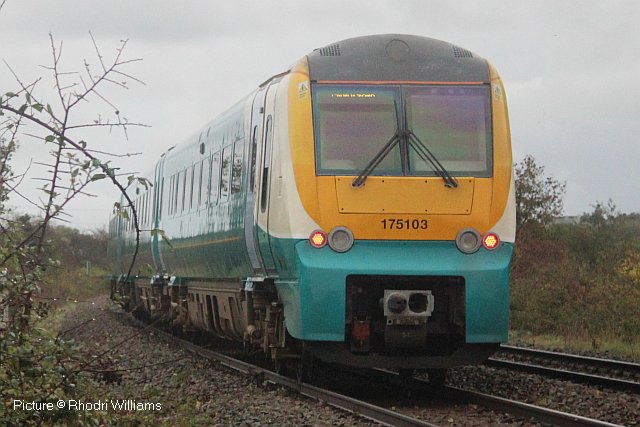
On the morning of the 'big day', Sunday 14 October, 175 103 passes Gaerwen with the first TfW train from Holyhead, 1K03 08:45 Holyhead - Crewe. (Picture is from a legal location.)
Does anyone know what was the last train on the whole ATW network?
First Day scenes
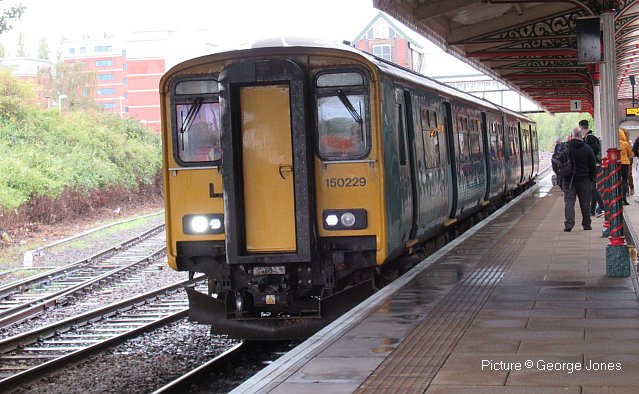
The first day of the new regime and whilst he didn't make the first train, George Jones was there to see 150 229 arrive on the 11:50 (a Chester - Birmingham train). No change there then!
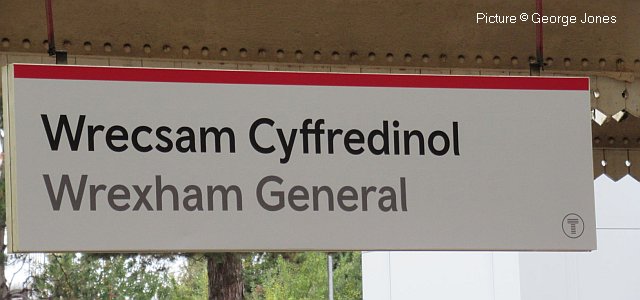
However, in her weekly notes from the Senedd, local AM Lesley Griffiths produced an otherwise unknown local gem - Wrexham General was to trial new stations boards - and sure enough here they are installed with a different typeface and small TfW symbol.
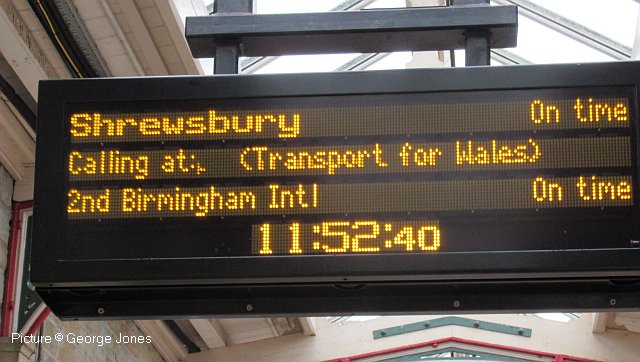
TfW appearing on the train indicator (George Jones).
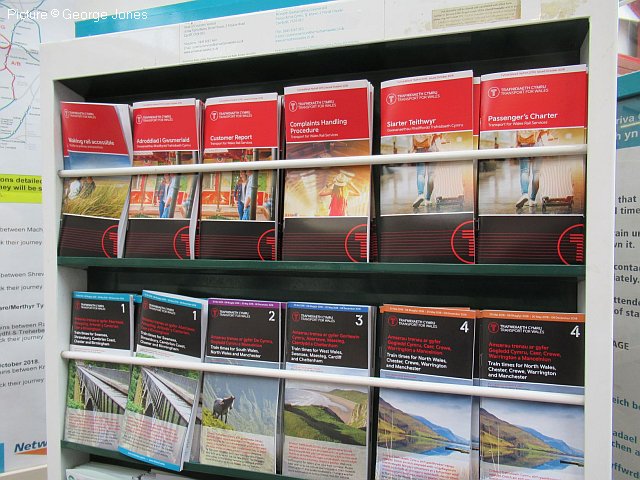
Brochures all reprinted with TfW logos. The Customer Report is particularly interesting with a timeline for assorted improvements over next 5 years. It will be worth keeping to check on progress as it happens (George Jones).
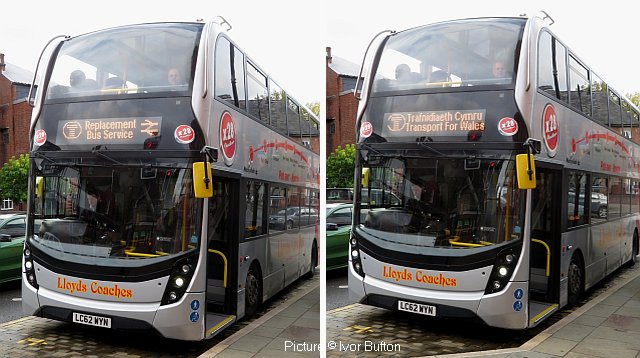
At Shrewsbury the first day, with rail replacements to ,Machynlleth and Newport, was busy. Lloyds Coaches are very fortunate to have an ex-GHA Coaches employee who is a genius at electronic destinations and he even had scrolling TfW destinations ready (Ivor Bufton).
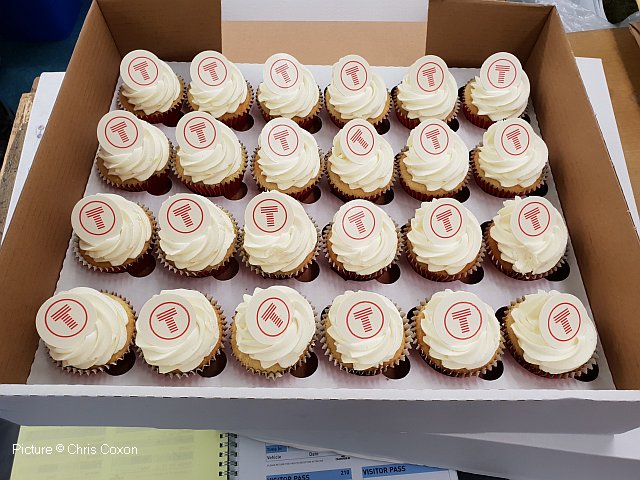
Chris Coxon visited Chester station, and spoke with a friendly member of staff who said that life was going on as usual and gave him a cupcake. Less positive was the availability of a booklet about accessible rail services in Welsh language only.
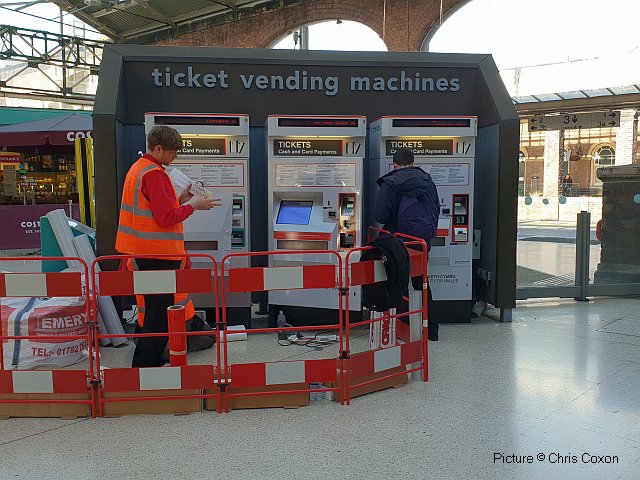
On 9 October at Chester, ticket machines were the subject of attention. Will they need various extra paper notices on them like the ATW ones, we wonder (Chris Coxon).
Arriva Trains Wales in retrospect - by Geraint Rowlands
As Arriva's tenure as franchise holder comes to a close, I thought it might be interesting to look back at where they started in December 2003. The Internet Archive's copy of Arriva's website, just after they acquired the franchise, includes PDF copies of their first timetables. Back then, rather than the five timetable booklets we're familiar with today, Arriva had eight, labelled A to F. Inside the front cover, Arriva lists some of their targets for the franchise:
Arriva is committed to providing a better service and in the new
franchise it will:
Maintain current levels of serviceThe timetables now covered by booklet 4 show the following service level in the January 2004 timetable:
Develop a revised user-friendly timetable giving better connections
and improved performance for long-distance and Valley Lines services
Provide additional diesel units to replace current less-suitable stock
and provide extra capacity
Increase compensation to passengers delayed by more than one hour to a
full refund of the value of their journey
Introduce 30 new bus/rail integrated ticket schemes and retain all
existing arrangements
Improve bi-lingual access to services including a Welsh language
customer service phone line from May 2004
Launch a 'Station Adopter scheme
Improve car parks at Cardiff, Chester, Hereford, Newport and Shrewsbury
Abolish the reservation charge for bicycles on trains."
Chester to Shrewsbury had some two hour gaps in its hourly service, and nearly half of the services were just shuttles to Shrewsbury.
There were half a dozen through services to Birmingham, and a handful to Cardiff. On Sundays buses replaced services south of Wrexham for the whole timetable period, at two- to three-hourly intervals.
The Borderlands line's service is virtually unchanged Monday - Saturday, but there were only three trains each way on Sundays, compared with today's six.
Six trains each way were provided on the Conwy Valley, similar to today, but there were also three scheduled bus services (two down one up). On Sunday, there were three scheduled buses each way over the winter, whereas there's nothing timetabled nowadays.
On the North Wales Coast, Flint station was served mainly by the hourly Llandudno - Manchester stopper, much as Shotton and Abergele are today: only a handful of Bangor/Holyhead services called there. Six ATW services started/terminated at Bangor, leaving Holyhead with some long gaps between departures (09:51-11:52-13:27, and 16:46-18:22). There was however a night boat train from Crewe at midnight, returning at 01:50 running limited stop via Crewe to Birmingham New Street. Most Holyhead/Bangor services ran to/from Crewe, with some extended to Birmingham New St, as well as a few to Manchester, and only one to Cardiff.
Class 40 down the Coast
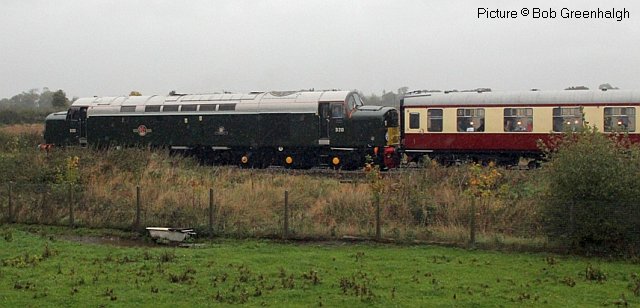
Saturday 13 October, a stormy sort of day, was the chosen day for the Saphos Trains 'North Wales Coast Express' excursion from Crewe to Holyhead featuring Class 40 loco D213 Andania, which has been hired from its owners on a three-year contract, and fitted for main line operation by Jeremy Hosking's Locomotive Services company. There had been doubts about the running of this train die to possible fallen trees and flooding. In the event, it went ahead but with a run to Llandudno replacing the Conwy Valley line which was blocked. We pick it up at Beeches Farm west of Chester pictured by Bob Greenhalgh.
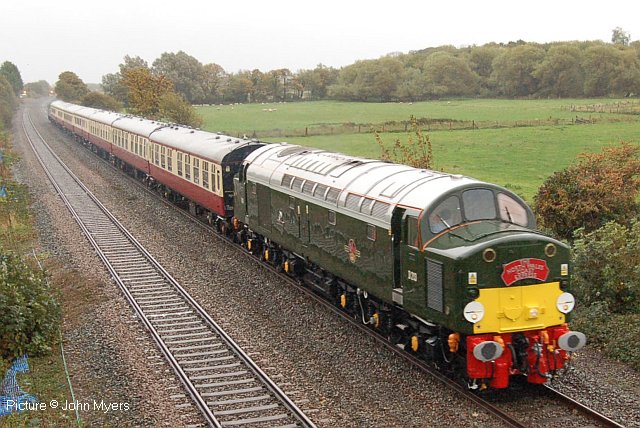
East of Prestatyn ...
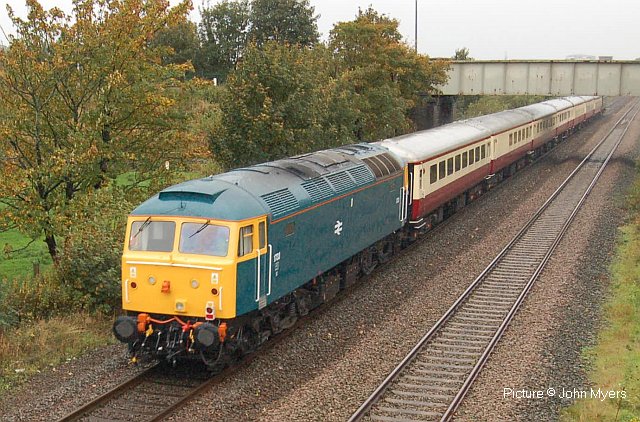
... with Hosking acquisition 1733 (ex 47 853) on the rear (John Myers).
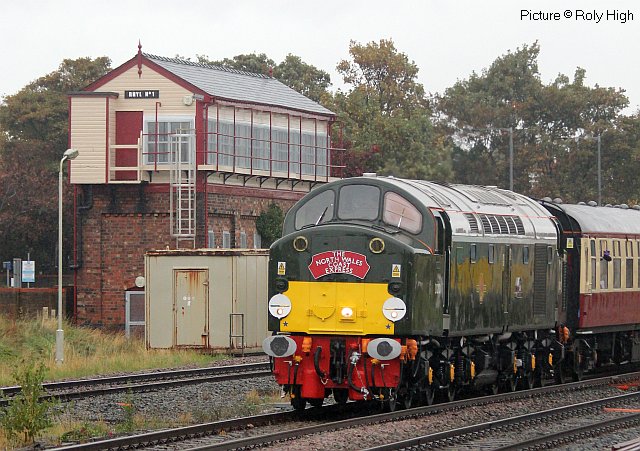
Rhyl (Roly High). No.1 signalbox looks good in London Midland Region colours, as repainted by Network Rail on closure as a token of its Grade II listed status, but what does its future hold?
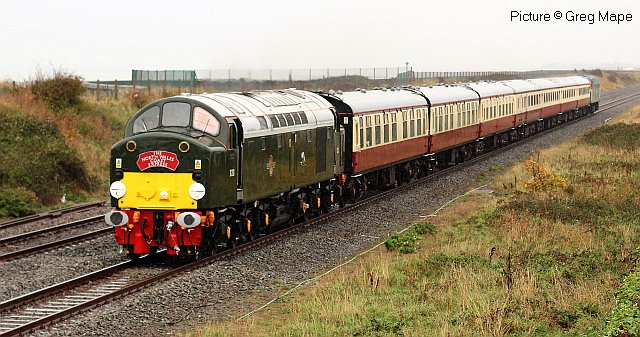
Abergele (Greg Mape). The Locomotive Services 'Icons of Steam' website describes D213 as 'one of the younger members of the class'. Perhaps they mean one of the earliest-built members, as the number series started at D200.
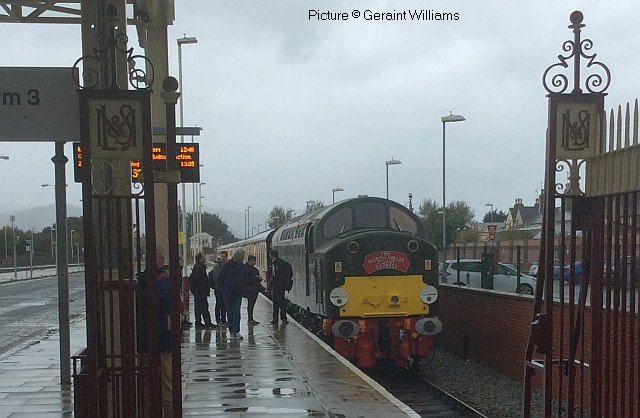
Llandudno, with admirers braving the rain (Geraint Williams). The English Electric 'Type 4' Diesel-electrics, later dubbed Class 40, are a 2000 HP design, built from 1958 to 1962, as Wikipedia puts it, 'at the time the pride of the British Rail diesel fleet.' Developed from earlier prototype, the weight of the engine, generators and other equipment required them to have eight axles (of which six are powered) to keep the force of each wheel on the track within acceptable bounds - thus they are classified as 1Co-Co1 in the British system. In later years, equivalent of greater power has been safely achieved with just six (Class 47) or even four (class 67) axles.
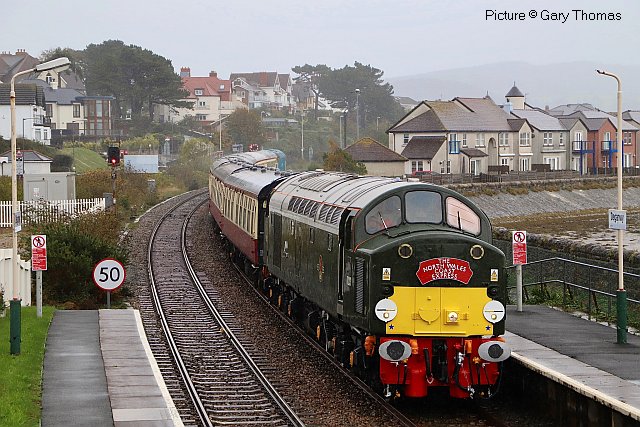
The 12:15 Llandudno - Holyhead passes Deganwy. The rain was torrential for much of the day. D213 is one of a series of locos named after ocean liners. in the days when the railway ran transatlantic boat trains to Liverpool Riverside station. The last ship to carrying the name Andania was a Cunard liner built in 1921 for the Atlantic run, one of six members of the 'A class'. Requisitioned by the Admiralty as an 'armed merchant cruiser', she sank after being hit by a torpedo fired by German U-boat in 1940. Cunard used names ending in 'ia' for most of their vessels, leading to some obscure derivations: Andania is a small town in Greece.
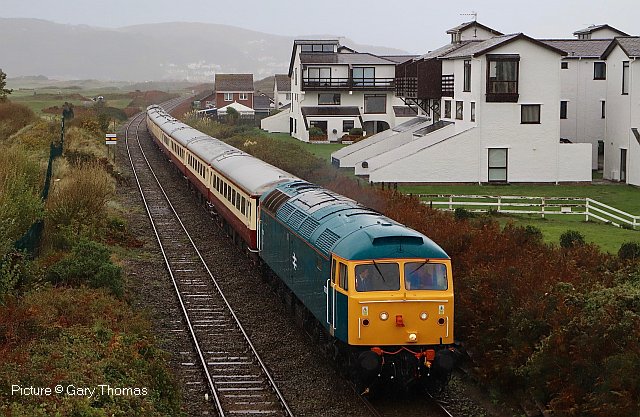
1733 (47 853 the former XP64 liveried Rail Express), returned the train to Llandudno Junction, seen passing the housing development known locally as 'Legoland' on the outskirts of Deganwy (Gary Thomas).
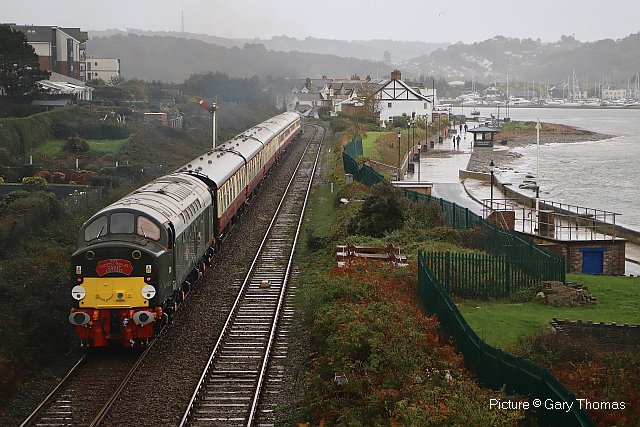
Andania on the rear as the train approaches Deganwy (Gary Thomas). There is a detailed history of the loco, known as 40 013 during the British Rail era, on the owner's website. After withdrawal in 1985 it spent some time as the London Midland Region's 'exhibition loco', being towed to various open days and other events; in 1988 it was sold to Trevor Dean for preservation.
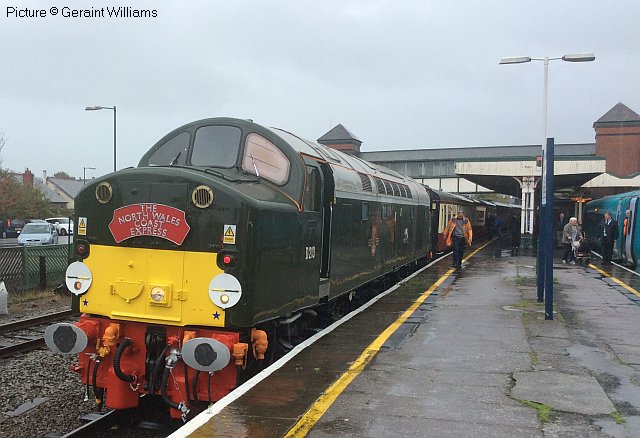
Back at Llandudno Junction, about to head for Holyhead (Geraint Williams). 40 013 was for a while in the early 1980s to be seen in North Wales, along with other Class 40s, working passenger trains from Manchester Victoria to Bangor or Holyhead, and sometimes Freightliner trains to Holyhead. (See the Class 40 Motherlist)
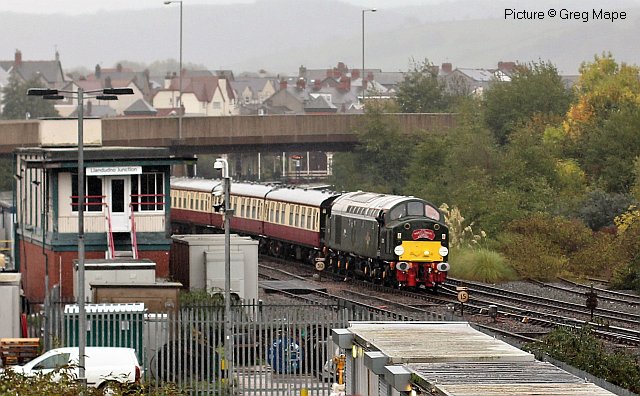
Departing Llandudno Junction for Holyhead, replacing the planned trip to Blaenau Ffestiniog ...
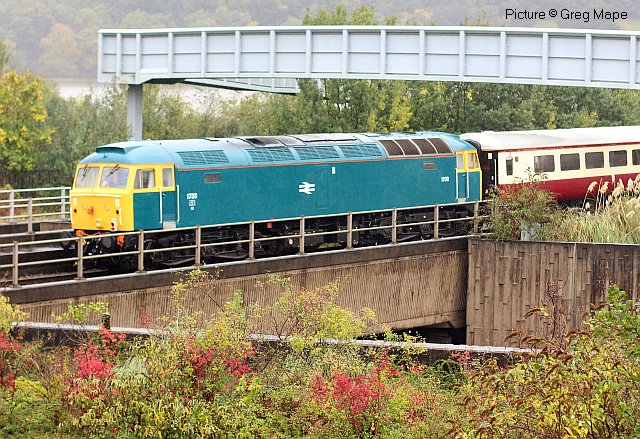
... with 1733 (47 853) on the rear (Greg Mape). Down below is the A55 Expressway Road on the approach to its tunnel under the Conwy estuary.
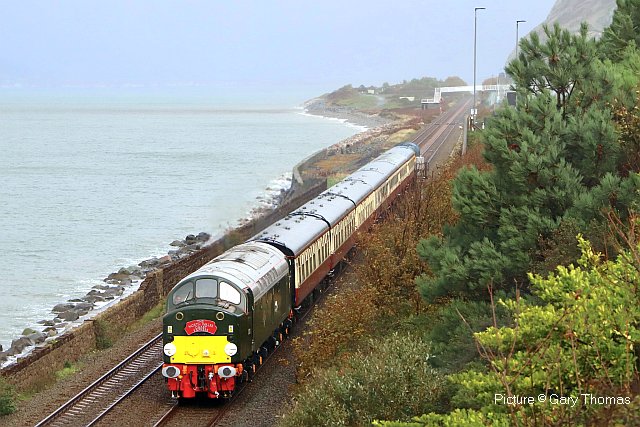
Approaching Penmaenmawr. Picture by Gary Thomas, who writes: The temporary closure of the petrol station and cafe next to the iron bridge led me to park next to Penmaenmawr station for a brisk jog up to the roundabout near the Gladstone pub in Dwygyfylchi. I didn't quite make it as the 40 was in fine fettle and early, so this was the best I could do. I'm still pleased I didn't try and cross the A55 on foot to get to the roundabout, far too dangerous.'
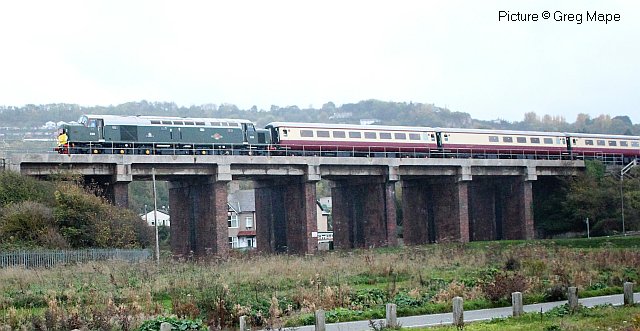
Homeward bound through Llandulas as 1Z42, 17:15 Holyhead - Crewe (Greg Mape).
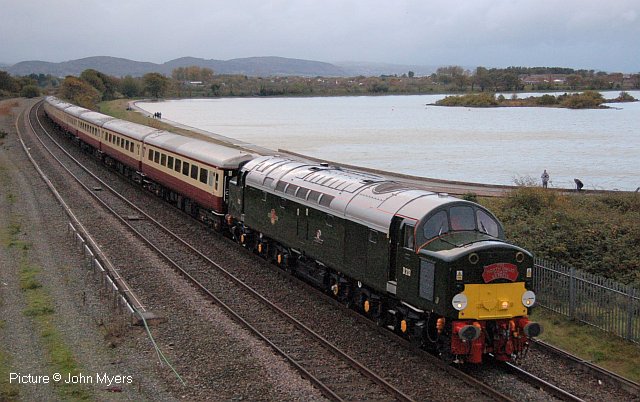
John Myers writes: 'After what was a fairly pleasant afternoon in Rhyl, the weather deteriorated again shortly before the tour was due to pass. A four-car train, comprised unusually of Northern-liveried Class 150 stock, formed the preceding 1H83 17:44 Llandudno-Manchester working (see below) and it would seem that the returning special had soon caught it up, causing D213 and its train to pass me by Rhyl Marine Lake fairly slowly but with the advantage that a slower shutter speed could be selected to compensate for the dusk conditions.'
A friend from the North
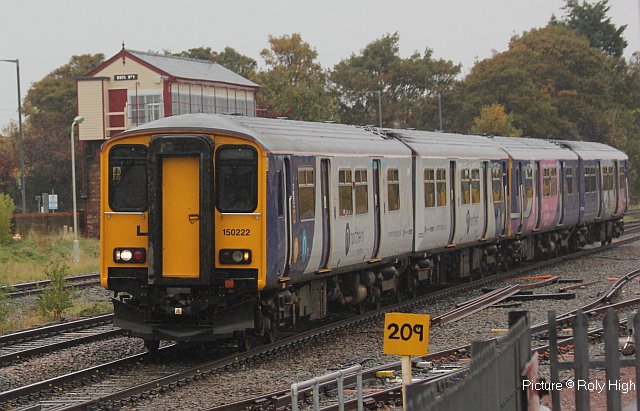
Possibly slightly less exciting that other events on 13 October, Arriva Trains Wales again 'borrowed' a train from Northern, where the 31st one-day strike of conductors was under way. It is seen at Rhyl (above, Roly High), and Abergele (Below, Greg Mape). The four-car train formed of 150 222 and 150 215 spent the day working between Manchester and Llandudno; ATW passengers might not have appreciated this, as the Northern Class 150s retain a 3+2 seating layout, unlike the ATW 150s which have much more comfortable seating.
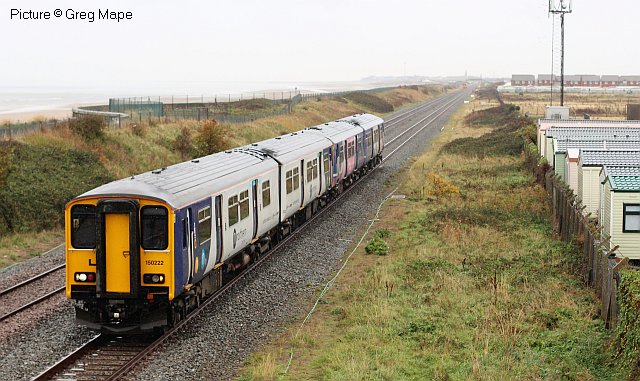
We wonder whether this arrangement will repeat in the future, since the companies will no longer share an overall ownership. Perhaps the load of a train from Arriva North to Arriva Wales is in return for the extra calls being made on strike days by ATW services at Alderley Edge, Holmes Chapel and Patricroft, although these didn't happen on 13 October and it doesn't seem likely they will happen in future. Stations from Alderley Edge to Sandbach will have no trains at all on 20 October.
Freight in the 1980s - remembered by Chris Jones-Bridger
I was interested to read Barrie Hughes' comments about freight traffic. I was Traffic Manager at Holyhead between 1982 and 1984 when North Wales freight was vibrant & even showing signs of expansion.
The core Freightliner plan had actually settled on 4 services. A morning arrival from Crewe & evening arrivals from Birmingham Lawley Street, Trafford Park and Willesden. In the Up direction, departures had become Stratford, Trafford Park and Lawley Street with an early evening departure to Crewe. The core evening arrivals and morning departures fed into the Sealink container ships sailing to Belfast & Dublin. An important traffic contributing to the fourth service and justifying an extension of the morning Willesden service to Stratford was an inter-plant flow of car components for Ford between Dagenham and their plant near Cork utilising a non-Sealink sailing from Holyhead. [The Cork plant, opened in 1919 to build tractors, closed in 1985, according to an interesting Irish Times article.]
Following the sale of Sealink to Sea Containers the already fragile finances of the Irish container services came under the microscope. From being an integrated BR owned operation each element ships, terminal and trains had to be seen to make money. This is when Freighliner started to
explore other options to an already marginal business and unfortunately Holyhead became a casualty as traffic was diverted via Seaforth & Ellesmere Port.
As for other freight traffic, It was just after my arrival that the flasks were removed from the wagonload trip which was quite a mixed bag. Llandudno Junction provided the hub for the the daily feeder trip to Holyhead serving customers as required. A mix of modern air-braked wagons
and older vacuum/unbraked vehicles (generally coal wagons were conveyed). At the time, bricks from Bangor and aluminium from Holyhead were key outward movements, in air-braked wagons for onward Speedlink services. Empty vacuum-fitted cement 'Presflo' wagons returning to Penyffordd from Bangor also featured. Overhauled Freighliner flats fed into Holyhead which at the time was a
principal maintenance location for Freightliner vehicles.
Sadly, volumes of aluminium from the smelter were always small as road haulage operators had taken advantage of the interruption of service caused by the long closure of the Britannia Bridge after the 1970 fire to secure the traffic from rail.
An interesting development during my time at Holyhead was the involvement of Stockton Haulage. As I recall this firm was an early recipient of a 'section 8 grant' for a Speedlink flow of steel through Stranraer to Northern Ireland. Having initially used Valley as a transshipment siding, the cattle sidings at Holyhead were redeveloped for a similar flow via the 'ro-ro' ferries from Holyhead. In order to provide covered accommodation for the steel the old carriage sheds were reconnected for this customer.
All in all expansionary times & a contrast to the lack of freight activity now.
(Chris also reminds us that there has only ever been one crossover between the Up and Down lines at Valley.)
Locomotive action miscellany
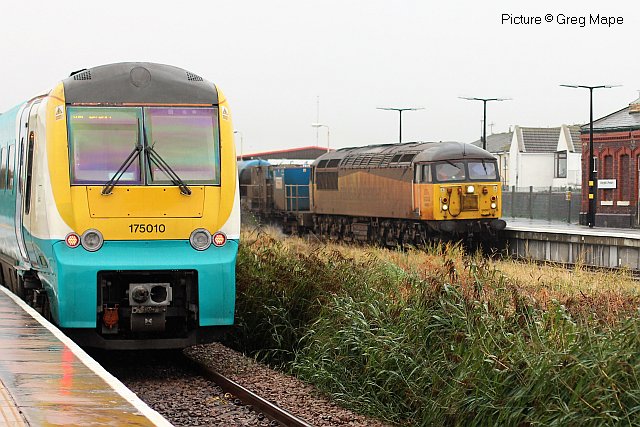
Abergele on 13 October: 56 087 heading the westbound Rail Head Treatment train passes 175 010 working 1H85 Llandudno - Manchester Airport (Greg Mape).
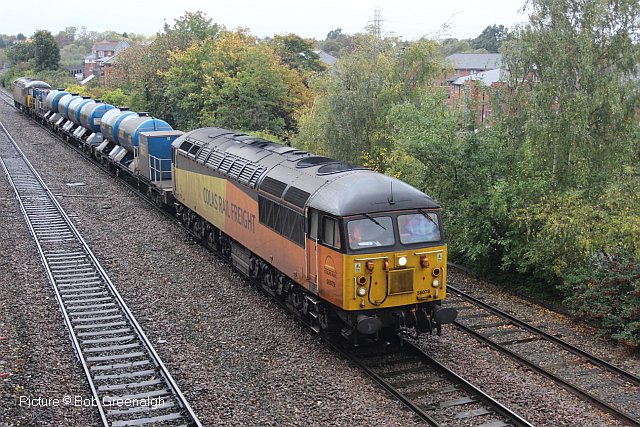
The previous day, 12 June, 56 078 leads on to Roodee Viaduct on the approach to Chester (Bob Greenhalgh).
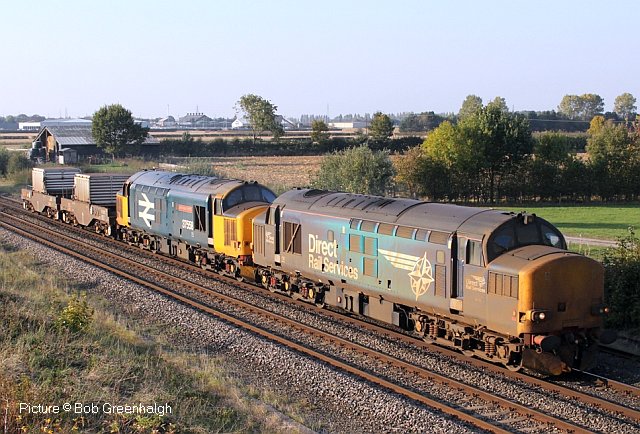
After some weeks of operation by Class 68 or 88 locos, Class 37s have re-appeared on the flask train, as seen on 10 October at Beeches Farm by Bob Greenhalgh. The locos are 37 218 and 37 424 Avro Vulcan XH558.
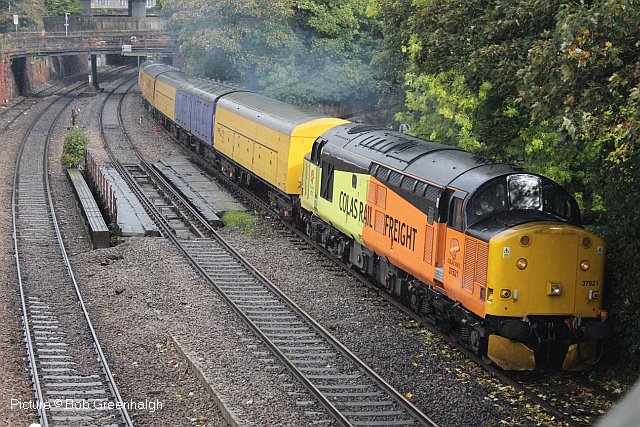
More classic traction on 12 October, with 37 521 on a Network Rail train, seen leaving Chester with a working from Crewe to Shrewsbury (Bob Greenhalgh).
Cambrian Corner - with Ken Robinson
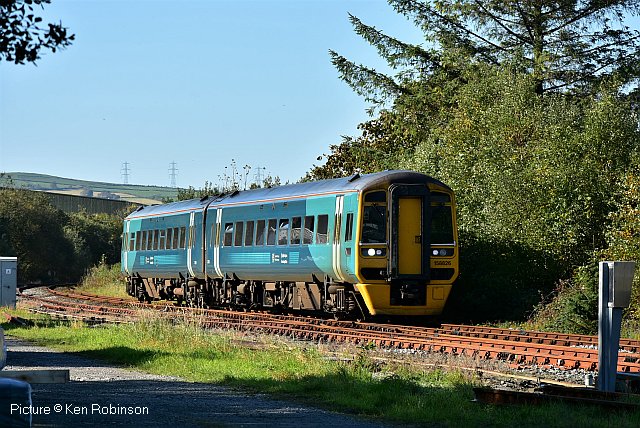
On a beautiful autumn sunny day, Wednesday 10 October, I couldn't resist taking a few photos, especially as ATW's franchise is nearing its end. Above, 158 826 approaches Porthmadog with the 13:38 Pwllheli-Birmingham International.
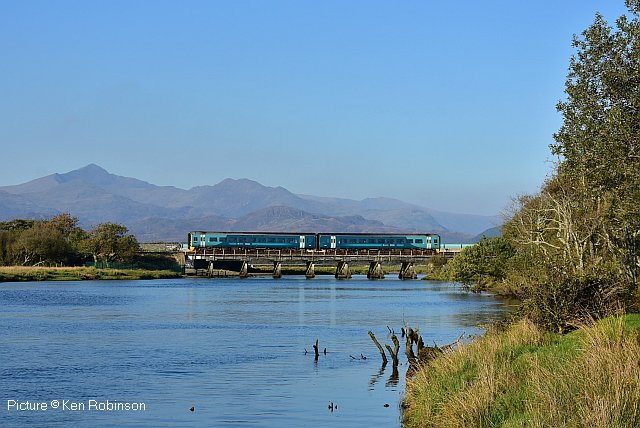
An unidentified 158 unit crosses the Afon Glaslyn, with Yr Wyddfa/Snowdon in the background, forming the 15:37 Pwllheli - Machynlleth.
Looking back - Blue Era scenes by Barrie Hughes

The Hertfordshire Railtours ‘Wirral Withershins’ of 18 January 1986, a dismal afternoon at about 3pm, entering the Mersey Docks and Harbours Board tracks at Borough Road with Mollington Street depot in the background. This train had originated in Victoria, coming via Oxford, Worcester and Stoke on Trent to Rock Ferry. It continued via Dee Marsh, Wrexham and Tyseley to regain its route at Oxford. 33 051 and 33 062 hauled the train. See the useful railtour history website Six Bells Junction for full details.
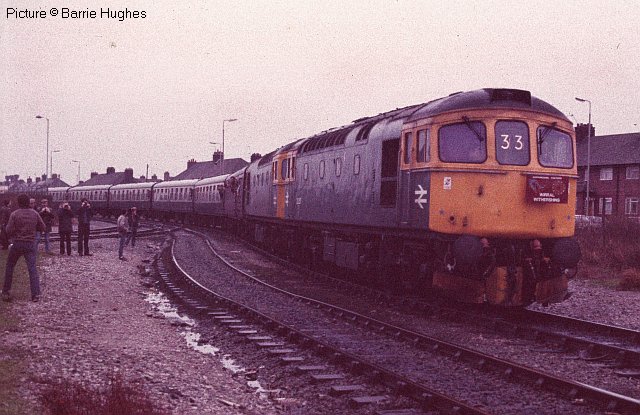
The train emerging from Mersey Docks and Harbour Board (MDHB) tracks at Wallasey Bridge road near Birkenhead North depot. The MDHB route is currently out of use but retained against a possible upsurge in Birkenhead Docks traffic.
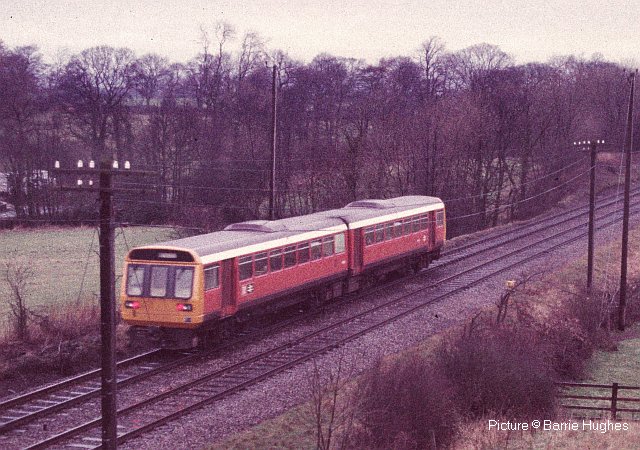
A Class 142 unit in Greater Manchester livery heading towards Shotton from Drury Lane bridge, Buckley, taken whilst waiting for the excursion to come up the Hawarden Bank.
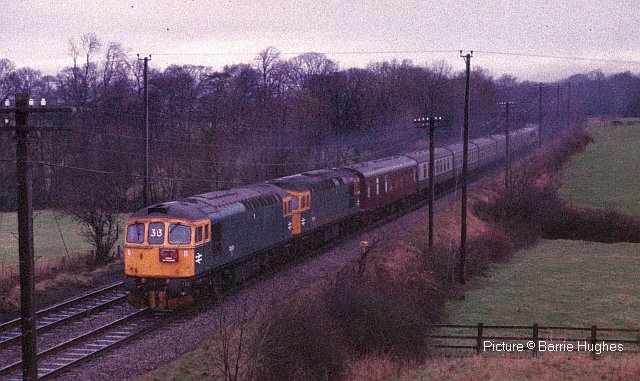
The railtour approaching Buckley Junction, the summit of the Hawarden Bank, at about 15:50 on 18 January 1986. 33 051 had a long life but was withdrawn on 31 August 2003 and cut up two months later at Eastleigh depot. However, 33 062 was withdrawn less than two years later on 23 September 1987 and cut up at Vic Berry’s Leicester scrapyard on 6 November 1990.
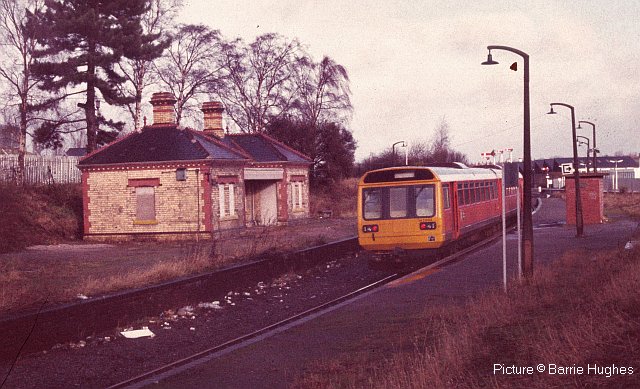
The following day I was returning home from my family visit to Buckley and called in at Wrexham. This view of Wrexham Exchange (today platform 4 of Wrexham General) on 19 January 1986 shows 142 004 heading north to Buckley, departing Wrexham Exchange with the track to Wrexham already singled and only the track nearer to Wrexham General retained so that (eventually) a footbridge could link the two stations.
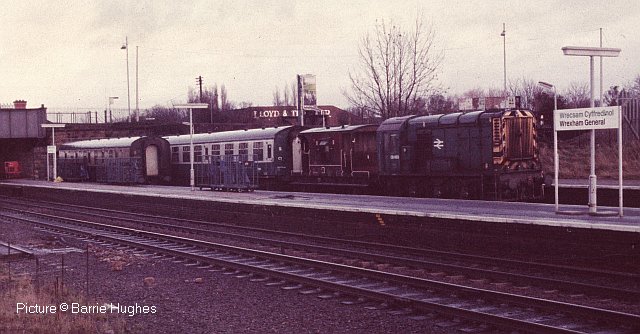
Was this the last loco to leave Wrexham? The stabling sidings on north curve Croesnewydd depot site were often occupied at weekends by 25s and 40s into the 80s but this practice may have ended with the closure of the Brymbo branch on 1 October 1982. 08 489 is seen stabled in the bay at the south end of Wrexham General, later used by W&S trains as a stabling point. Signs of the times include the van to be attached to a parcels train, and the BRUTE (British Railways Universal Trolley Equipment) trolleys/
The shunter’s side rods had been removed, so presumably this Class 08 was in transit to BREL Swindon which was maintaining shunters in the 80s. This loco had a long life including locally at Warrington, finally succumbing on 30 September 2008 before being broken up at TJ Thompson’s scrapyard at Stockton, but it lives on in model form as Hornby’s model R3342!
Carelessness
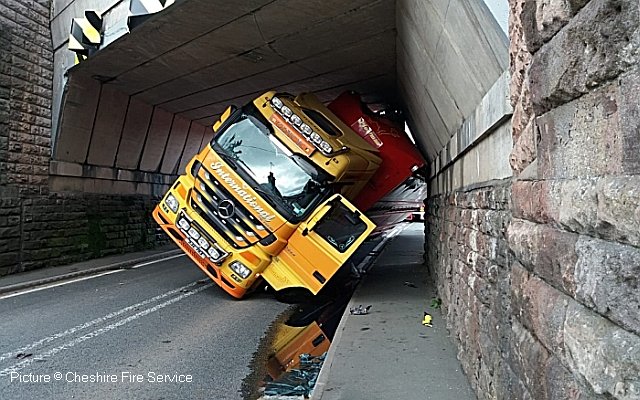
This month so far has seen two incidents in our area of railway bridges being struck by lorries. On 4 October such a vehicle designed to carry two decks of livestock (empty, fortunately) ran into the arch of the bridge carrying the Crewe - Chester line over Whitchurch Road, Beeston becoming wedged under the bridge at a 45 degree angle, as shown in the picture above from Cheshire Fire and Rescue Service. The railway was closed for some time while the lorry was extricated. The driver was not injured. The collision was captured on video by the CCTV of a nearby building, which can be seen on the Cheshire Standard website. The bridge is clearly signed with a 15-foot (4.5 metre) clearance.
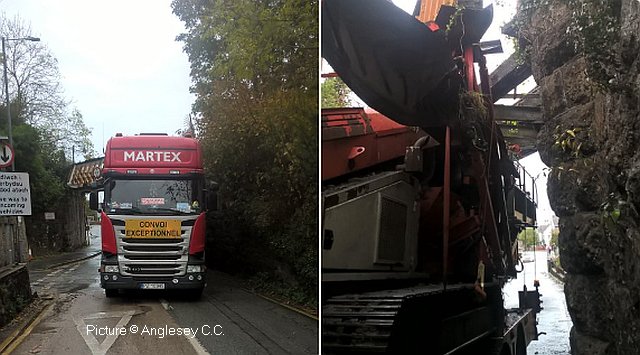
The second incident occurred on 11 October at the bridge carrying the currently-unused Amlwch branch line over the A5114 at Ffordd Glanhwfa in Llangefni, struck by a foreign-registered lorry carrying what appears to be some sort of machinery. The bridge span was dislodged from its abutments and fell on to the lorry; it was 14 October before the span was removed using two 100-tonne-capacity cranes. This will be a setback for supporters of the proposal to re-open the line.
A serious incident on the Crewe - Chester line occurred during the night of 19 September, and has recently been recorded on the Rail Accident Investigation Branch (RAIB) website. During a possession for track relaying, a road-rail ballast distributor vehicle travelling along the line from an access point at Calveley to the work site collided with stationary off-road utility vehicle carrying track workers, two of whom were injured. An investigation has been launched.
Llangollen Gala
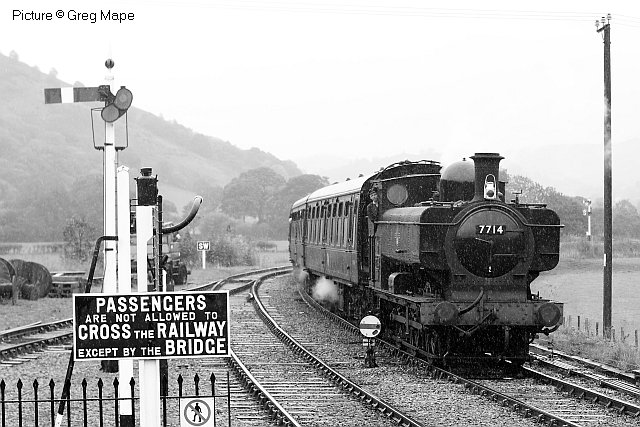
Several contributors braved the weather to visit the Cambrian-themed three-day steam gala on the Llangollen Railway. We've selected just a few. On Friday 12 October Greg Mape chose black-and-white to capture pannier tank 7714 arriving at Carrog ...
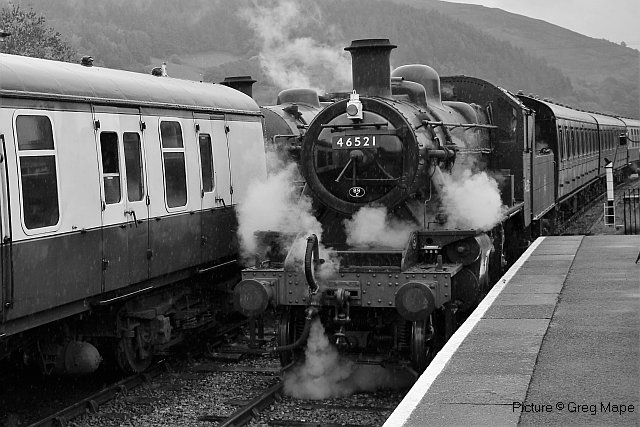
... and sometime Cambrian lines 2-6-0 46521 arriving at Llangollen.
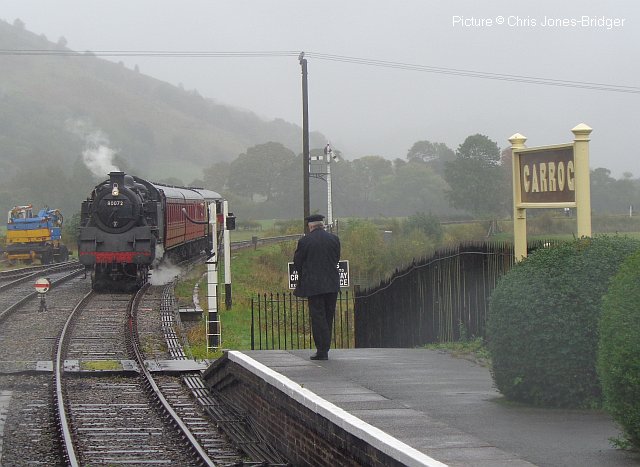
2-6-4T 80072 approaching Carrog with the 12:55 Llangollen to Corwen. The Carrog signalman waits in the rain to exchange tokens.
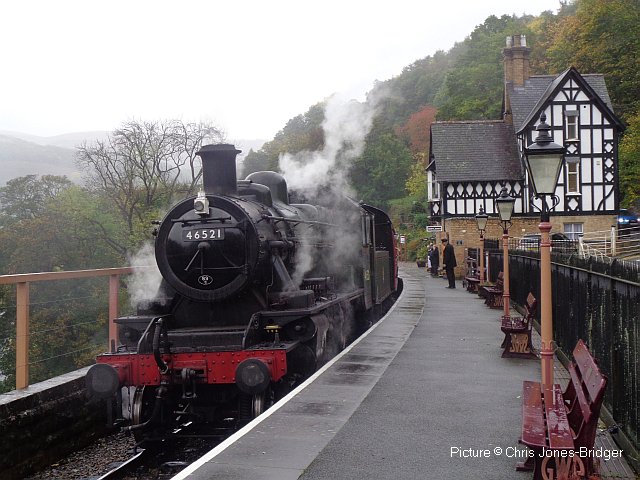
Guest 46521 from the Great Central Railway departing from Berwyn with the 16:00 Llangollen to Corwen (Chris Jones-Bridger).
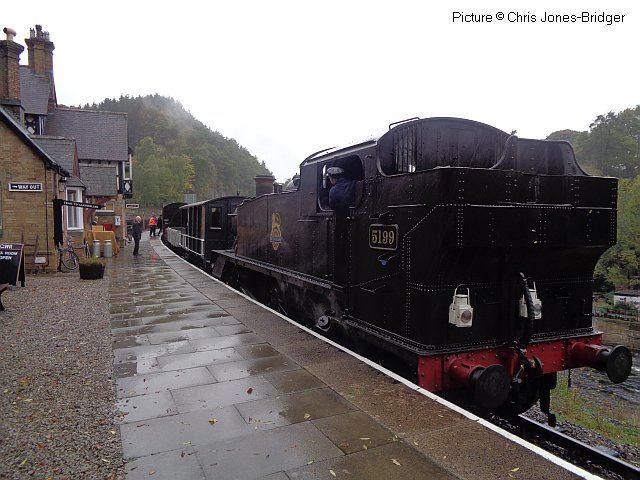
2-6-2T 5199 with the 16:05 mixed train from Glyndyfrdwy at Berwyn.
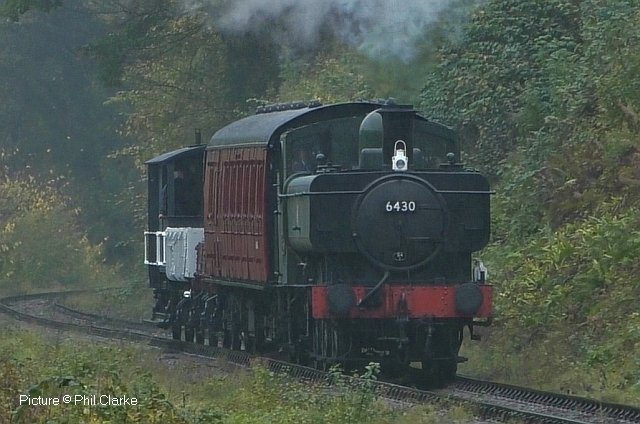
Saturday 13 October, and pannier tank 6430 makes its way with a mixed train towards Berwyn (Phil Clarke).
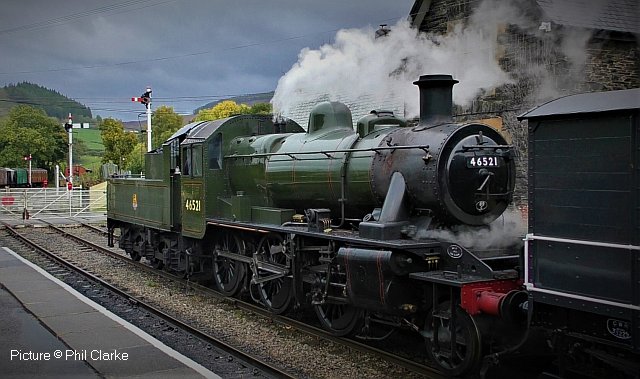
46521 shows off the green livery which it was adorned when on the Cambrian in the 60s (Phil Clarke).
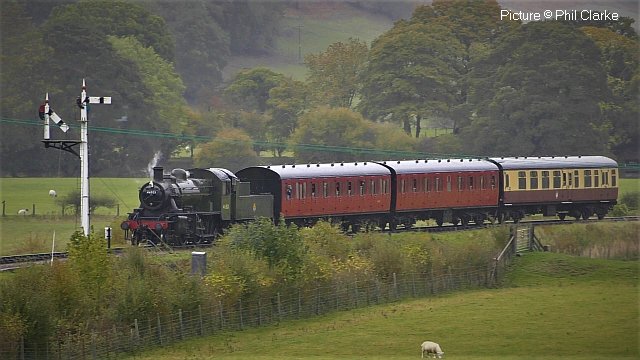
46521 approaches Carrog with a 'stopping' train, 13 October. Picture by Phil Clarke. Many more Gala views below.
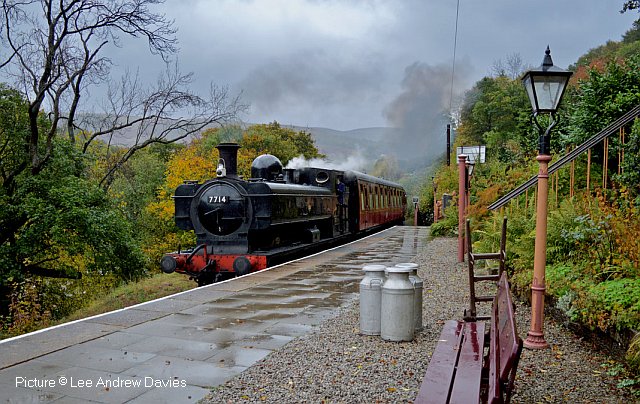
7714 arrives at Berwyn (Lee Andrew Davies). This loco, visiting from the Severn Valley Railway was built for the Great Western Railway in 1930 by Kerr, Stuart & Co. of Stoke-on-Trent. Withdrawn by British Railways in 1959, it was sold to the National Coal Board, being saved for preservation in 1973.
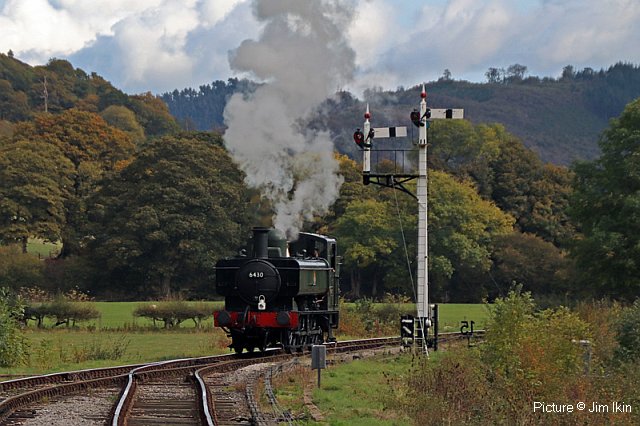
Sunday 14 October brought better weather; although with flood water lapping at the trackside in places. 6430 runs round at Carrog (Jim Ikin).
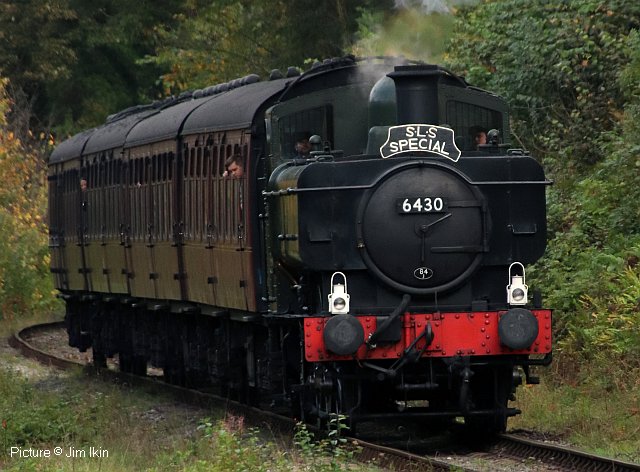
The Stephenson Locomotive Society's headboard adorned many railtours in 50s and 60s (Jim Ikin). The society still flourishes, but no longer charters trains.
North Wales Coast home page | Archive | Previous Notice Board